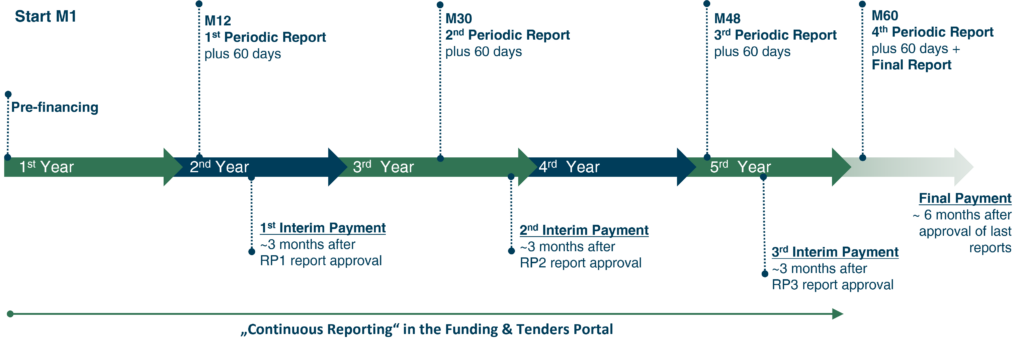From H2020 to Horizon Europe – our experiences from the first periodic reports
4th July 2023 at 4:20 pm
Now that your Horizon Europe project is up and running, your first periodic report (RP1 report) for the European Commission (EC) might be coming up soon. These reports represent a legal obligation towards the EC. They allow the EC Project Advisors and Financial Officers, who have been assigned to your project, (1) to verify your progress of work against the project description in Annex 1 of the Grant Agreement (GA), the so-called Description of the Action and (2) to assess the eligibility of the costs claimed by the project partners. This may be intimidating, but there is no need to worry!
Frequency of reporting – how often?
The number of reporting periods was determined during the grant preparation phase and depends on the duration of your project. Projects with a duration of between 24 and 36 months typically have two reporting periods, projects between 42 and 48 months have three, and those with 60 months four.

From continuous to periodic reporting – what is the benefit?
The EU Funding & Tenders Portal’s Continuous Reporting module was opened at the project start to facilitate the monitoring of your project and its proper implementation according to the EC rules. Once the Periodic Reporting is activated at the end of a reporting period, this module becomes part of your report, namely Part A. We recommend completing at least some of the forms of the Continuous Reporting module as you go along to be prepared for the periodic report(s).
H2020 and Horizon Europe periodic reports – same-same?
Based on our experiences from the first two recently submitted RP1 reports, we are happy to announce that the reporting process is virtually unchanged. For example, most projects have their RP1 report after 12 or 18 months and your consortium has 60 days after the end of each period to submit the respective periodic report. And the reports still consist of two elements:
- Part A, the project-specific online forms in the EU Funding & Tenders Portal. This part is based on the information entered into the Continuous Reporting and Periodic Reporting modules, including the financial statements, which are cost claims to be submitted in the portal by each project partner. (Note that this applies to Research and Innovation Actions, Innovation Actions and Coordination and Support Actions but not to Doctoral Networks and Lump Sum projects which follow different rules.)
- Part B, the Technical Report describing the work carried out during the reporting period, which must be uploaded as a PDF document into the portal.
There are, however, significant changes and additional requirements in Part A, the online forms in the portal (from 13 forms in H2020 to 17 forms in Horizon Europe). These require not only more information but also that partners log in and enter data. Given the quantity of details requested, it is highly advisable to start completing them immediately after or even before the end of a reporting period. Below, we provide guidance on what information must be provided to the EC in each of these online forms.
Facts and numbers in Part A
While the Continuous Reporting module is open throughout the duration of a project (and beyond), the Periodic Reporting module appears on the EU portal only after the reporting period has ended. As all the information included in the Continuous Reporting module transfers automatically to the Periodic Reporting module, the main practical difference between the two modules is that financial statements and the technical report can be added only to the Periodic Reporting module. Once the coordinator has all the information, the periodic report can be submitted through the latter. Here is what you need to populate in Part A – simply click on the according element in the interactive infographic below:
Description of work progress in Part B
Part B is the narrative description of the work carried out during the reporting period. The technical report template can be downloaded from the Periodic Reporting module. After it is compiled, it can be re-uploaded as PDF. The core body should consist of a description of the activities performed during the reporting period for each work package. The level of detail should be high, but bear in mind that the report must be concise and readable. There is no need to duplicate information already included in Part A, but references to specific elements in Part A are recommended. Particular attention should be given to deviations from the EC Grant Agreement, namely the Description of Action, as well as their possible consequences and proposed corrective actions. Additionally, delays and critical objectives, deliverables or milestones that have not been fully achieved should be explained.
In Horizon Europe, the consortium can still provide an update on open access and on the plan for exploitation and dissemination of results (these are two optional chapters in the part B template). In cases involving a transfer of costs categories, adjustments to previous financial statements or any other deviation in the budget, a justification must be provided in the “Use of resources” chapter.

As the technical report typically compiles contributions from all project partners, the template should be prepared and circulated in a timely manner so that all work package leaders can provide their input. As you are aware of the timing of the periodic reports, the input can be collected even before the Periodic Reporting module is open. Our experience suggests iterations are often needed between the working teams and the project coordinator. Images and annexes to complement the core information are more than welcome. An internal review process and several quality checks are recommended to ensure a high quality level of delivered content.
European Commission review meetings
Finally, the consortium may be invited for a review meeting organised by the Project Adviser and involving two to four external experts to evaluate your project’s progress. In this meeting, the coordinator typically presents the overall project achievements and status, whereas the work package leaders present the technical and scientific progress at the work package level. The experts are expected to review the draft periodic report and the submitted deliverables prior to the meeting and subsequently ask questions and provide feedback on the spot.

We recommend holding this meeting between the end of a reporting period and before the submission deadline of the periodic report. You need not present the final version of the technical report (an advanced version is sufficient), and your consortium can address the observations made by the evaluators update the final version after the review meeting and before the deadline. This provides the consortium with valuable insight before the final submission, as it can shorten the evaluation process of the periodic report. The EC may still request additional information, especially on the financial statements.
Regardless of the review meeting, the coordinator may still receive a “suspension of the payment” letter, because the approval of the periodic report is a precondition for receiving payments. However, there is no need to be terrified, as this only means that additional information is needed. Once this information is approved, the next payment will be released.
Horizon Europe reporting made easy
Our team at accelopment has successfully supported dozens of project consortia in the preparation of periodic reports. The lessons on continuous and periodic reporting learned from FP7, throughout H2020 and now in Horizon Europe have resulted in EU project management accelTOOLS, including the accelCOCKPIT®, a monitoring tool that can be adapted to projects to facilitate reporting. We have also developed templates tailored to support continuous and periodic reporting. These tools make it easier to compile and analyse information and act when deviations are identified. As a sparring partner in many EU-funded projects, we provide guidance and support with planning, monitoring and evaluation. If you are interested in learning more about our project management support, please contact one of our Research & Innovation Project Managers.


